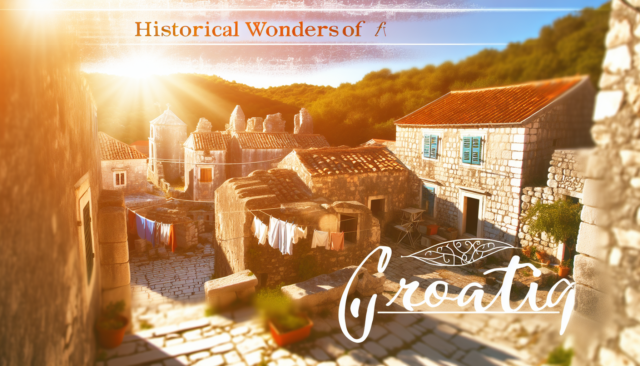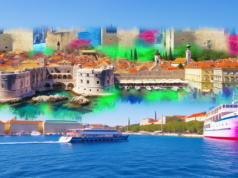
Historical Wonders of Croatia: Explore Ancient Towns and Ruins
Nestled in the heart of Southeast Europe, Croatia is a country that boasts an extraordinary blend of natural beauty and rich historical heritage. From ancient Roman ruins to medieval castles and charming towns frozen in time, Croatia offers a wealth of historical wonders waiting to be explored. This article takes you on a journey through some of the most remarkable ancient towns and ruins that reveal the stories of a land shaped by various cultures and civilizations.
1. Pula: The Roman Jewel
One of the finest examples of Roman architecture in Croatia is the ancient city of Pula, located on the southern tip of the Istrian Peninsula. The highlight of Pula is the well-preserved Roman amphitheater, known as the Arena. Built in the 1st century AD, it is one of the largest and best-preserved Roman amphitheaters in the world. It once hosted gladiatorial contests and is still used today for concerts and events. Wandering through the winding streets of Pula, visitors can also explore other Roman ruins, including the Temple of Augustus and the Arch of the Sergii, which speak volumes about the city’s former grandeur.
2. Split: The Palace of Diocletian
Split, Croatia’s second-largest city, is an extraordinary blend of ancient and modern. The heart of Split is the UNESCO World Heritage site of Diocletian’s Palace, built by the Roman Emperor Diocletian in the 4th century AD. This monumental structure is not just a palace but a city in itself, complete with residential quarters, temples, and a mausoleum that later became the Cathedral of Saint Domnius. The lively atmosphere in the palace’s narrow streets, where cafes and shops coexist with ancient stone walls, creates a unique experience. Exploring this historical complex allows visitors to step back in time and feel the pulse of Roman life.
3. Dubrovnik: The Pearl of the Adriatic
Dubrovnik, often referred to as the "Pearl of the Adriatic," is a stunning coastal city that has captivated generations with its beauty and historical significance. The city’s well-preserved Old Town is encircled by a formidable fortress-like wall, offering panoramic views of the Adriatic Sea. Walking along the Stradun, the main street, visitors encounter elegant baroque architecture, the Rector’s Palace, and the Dominican Monastery, which dates back to the 14th century. Dubrovnik’s history is deeply interwoven with trade, diplomacy, and maritime power during the Republic of Ragusa, making it a fascinating destination for history enthusiasts.
4. Trogir: A Medieval Masterpiece
Just a short drive from Split lies Trogir, a small medieval town that is a UNESCO World Heritage site. Founded by the Greeks in the 3rd century BC, Trogir boasts an impressive collection of Romanesque and Gothic architecture. The Cathedral of St. Lawrence, with its exquisite portal carved by Radovan, is a must-see, as is the Kamerlengo Fortress that dominates the waterfront. The town’s narrow streets and charming squares evoke a sense of timelessness, allowing visitors to meander through history as they explore this coastal gem.
5. Zadar: A Tapestry of Cultures
Zadar, one of Croatia’s oldest continuously inhabited cities, serves as a captivating crossroads of history. Its stunning Roman Forum, nestled beneath the shadows of St. Donatus Church—a remarkable example of early medieval architecture—reflects its ancient past. Visitors can also marvel at the Sea Organ and the Sun Salutation installations, where ancient heritage intertwines with contemporary art. Zadar’s unique blend of cultures, from Roman to Venetian, creates a rich tapestry of history that invites exploration.
6. Sibenik: The Fortress City
Known for its stunning Cathedral of St. James, a UNESCO World Heritage site, Sibenik is a fortified city that showcases Croatia’s medieval architecture and rich history. The cathedral, famous for its unique blend of Gothic and Renaissance styles, was built from local stone and boasts remarkable sculptural details. The star-shaped fortress of St. Nicholas, which guards the entrance to Sibenik’s harbor, is another historical treasure that offers spectacular views of the surrounding area.
Conclusion
Croatia’s historical wonders beckon travelers to uncover the layers of its past, where ancient civilizations once thrived and left behind a wealth of remarkable sites. From the majestic amphitheaters of Pula to the enchanting streets of Dubrovnik and the ancient ruins of Trogir, each location tells a unique story that enriches our understanding of the country’s history. As you explore these ancient towns and ruins, the echoes of the past will resonate through the stones and landscapes, inviting you to create your own connection to this magical land. Whether you’re a history buff, a culture enthusiast, or a casual traveler, Croatia’s historical treasures promise an unforgettable adventure through time.













